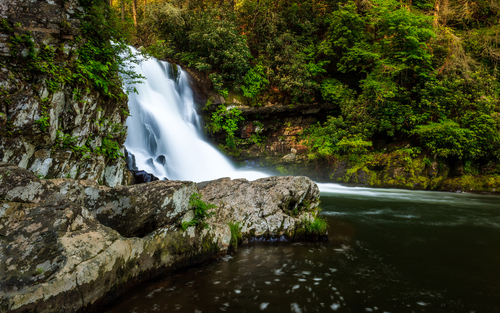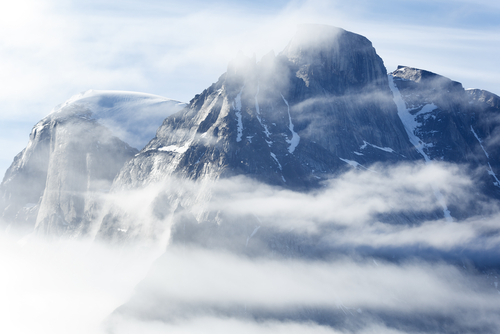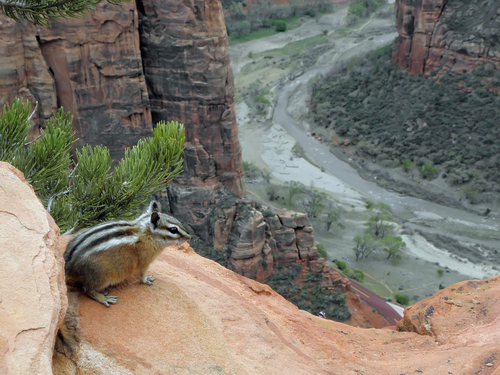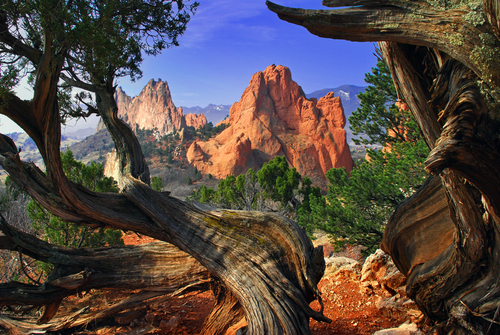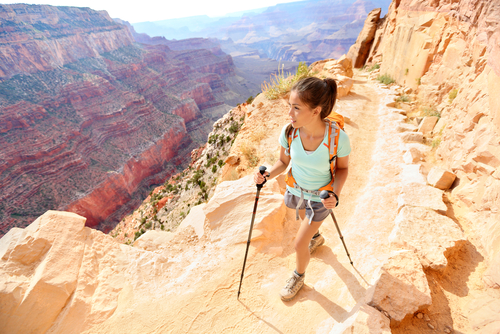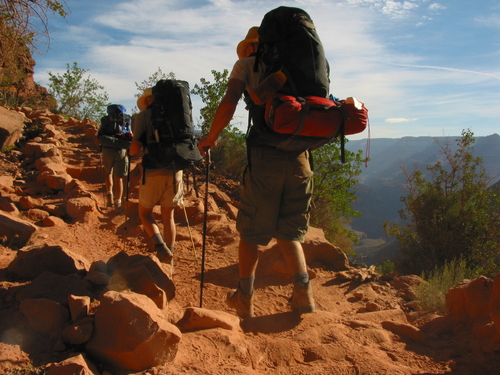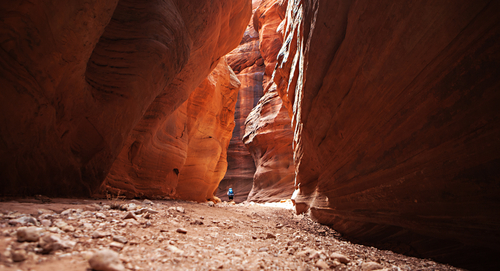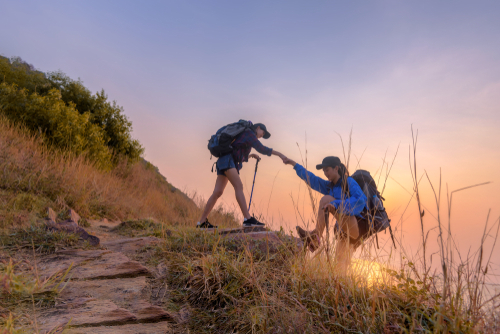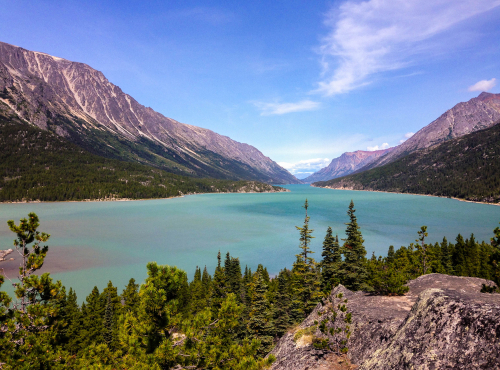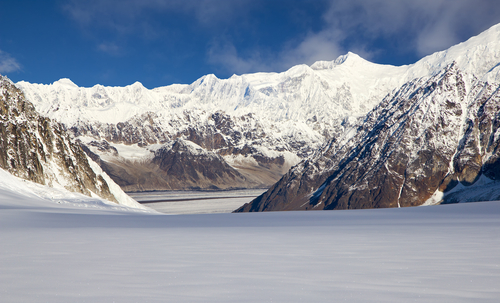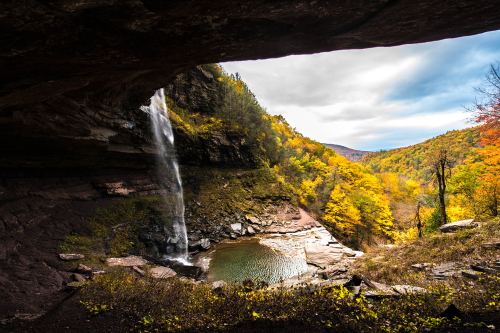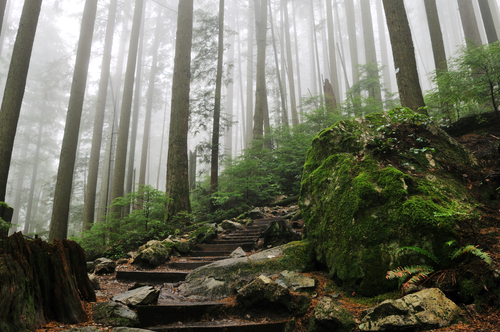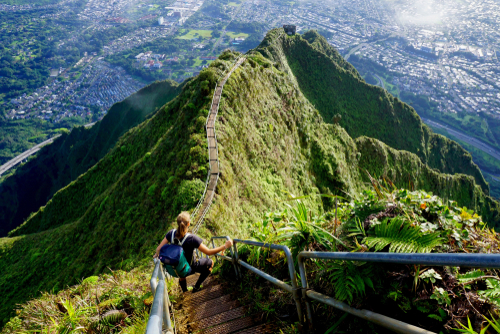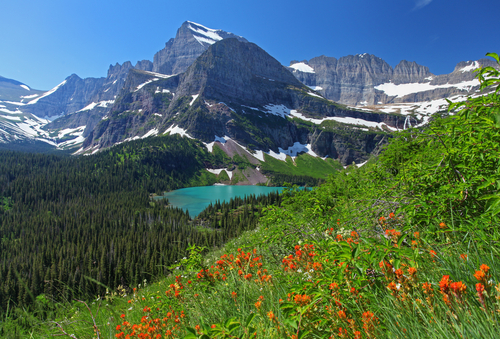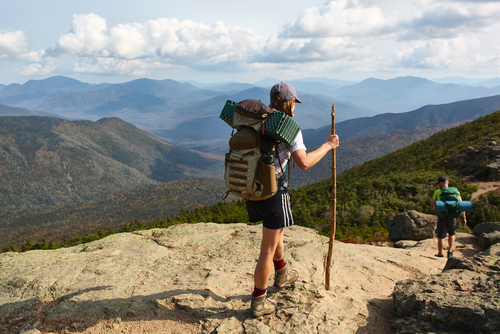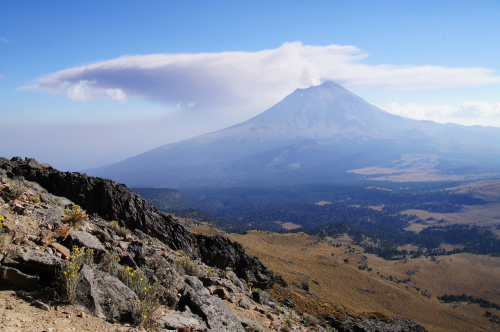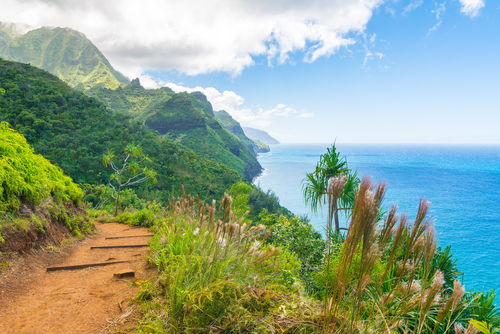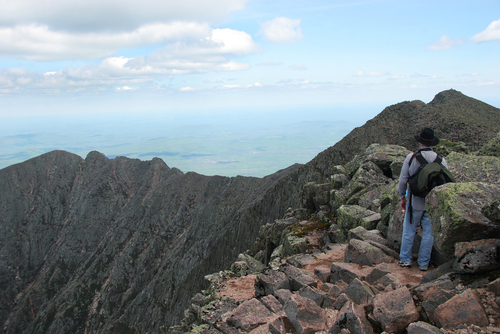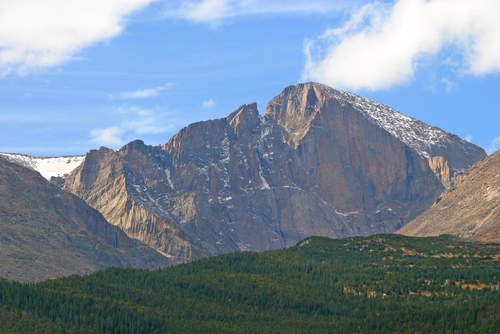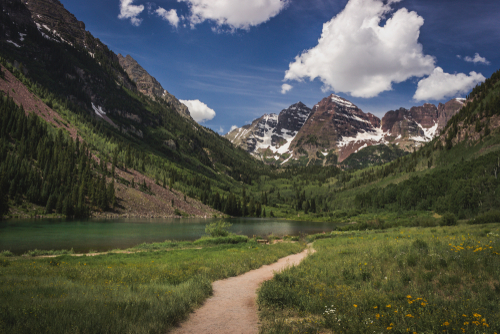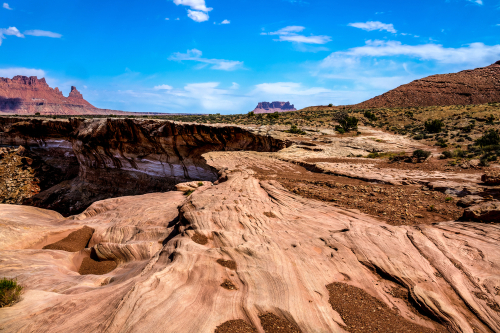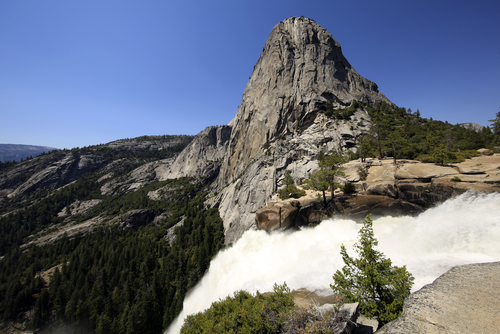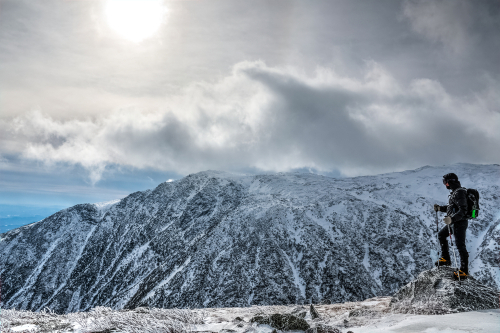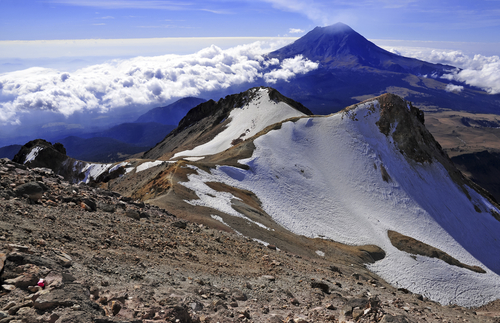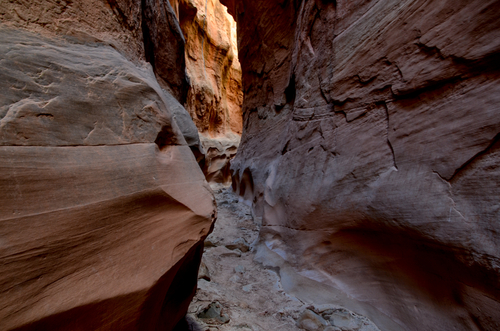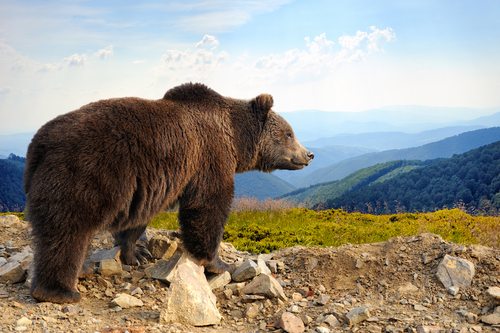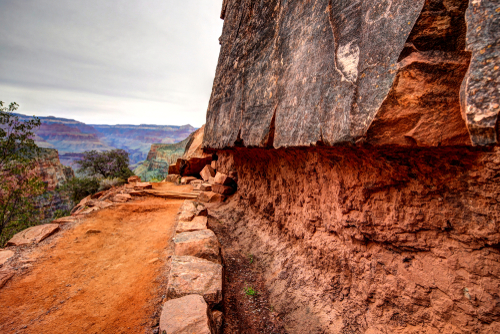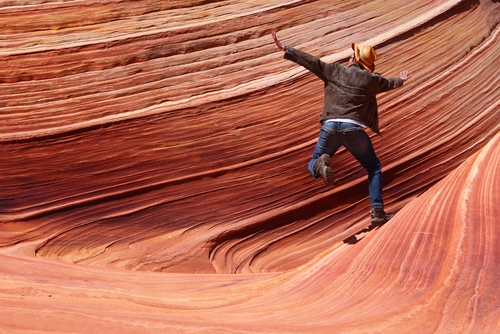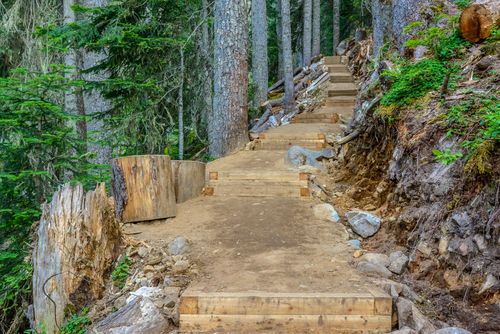The awesomeness of a beautiful view, the burning that comes with a steep climb, the overwhelming sense of accomplishment. Hiking is a thrilling adventure.
Of course, some hikes are more thrilling than others. On North America’s most dangerous hikes, the beautiful view comes after hours spent walking a steep path next to a potentially fatal vertical drop. There’s still an overwhelming sense of accomplishment, but it’s mixed with relief for having survived. Okay, maybe we’re exaggerating — but just a little. The following are the 30 most thrilling (read: dangerous) hikes in North America.
Abrams Falls
Great Smoky Mountains, Tennessee
Though they enjoy a reputation for being absolutely beautiful, the Great Smoky Mountains aren’t exactly known for being thrilling or dangerous. One exception to that is Abrams Falls. About 30 people have died on this 2.5-mile trail since 1971, and most of those deaths have been due to drowning. These mountains experience approximately 85 inches of rainfall each year, and flash flooding is a real danger. Additionally, the trail has more than one inviting swimming hole along its route. Overheated hikers often jump in to cool off, only to be swept under by dangerous undercurrents. But did we mention these mountains are beautiful?
Akshayuk Pass
Cumberland Peninsula, Baffin Island
Located in the Arctic Circle, Akshayuk Pass is extremely difficult to get to — and that’s not even the hardest part! Over the course of about eight days and 97 kilometers (60.2 miles), hikers taking on this thrilling trail will face rough terrain, some steep inclines, river crossings (which can be especially challenging in bad weather), and even polar bears. Fortunately, there are eight frequently used emergency huts situated along the way for hikers. Akshayuk Pass may be one of North America’s most remote trails, but this beautiful hike is worth every inevitable challenge faced along the way.
Angel’s Landing
Zion National Park, Utah
Zion National Park’s Angel’s Landing is perhaps the most famous thrilling hike in the United States. The beginning part of the hike is safe and welcoming, almost like a trap luring in unsuspecting hikers. Before long, climbers face a narrow trail with vertical cliffs on one side and a 1,000-foot drop on the other. In some places, the path is just wide enough for one person. One especially harrowing section of the trail requires hikers to manage a three-foot-wide crossing with a 1,000-foot drop on either side and nothing to hold onto. Angel’s Landing takes some serious nerves to conquer. In the last six years, at least five people have fallen to their deaths on this thrilling hike.
Barr Trail
Pikes Peak, Colorado
Barr Trail on Colorado’s Pikes Peak gains 7,400 feet over the course of 13 miles, ensuring hikers get their exercise — along with some stunning views in the process. Aside from some steep vertical terrain, this trail isn’t so bad. Well, except for the weather. Unfortunately, Pikes Peak has a reputation as a magnet for lightning strikes. In fact, since the year 2000, about 25 people have been struck by lightning while hiking Barr Trail, and only a few have survived the ordeal. Anyone taking on Pikes Peak while there are thunderstorms in the forecast should avoid it altogether, or at least be brave enough to turn back at the first sign of gathering grey clouds.
Boucher Trail
The Grand Canyon, Arizona
Even experienced hikers face challenges on the Boucher (pronounced boo-shay) Trail. In addition to being one of the Grand Canyon’s most secluded trails, the Boucher makes for a steep hike that is often tough to traverse. Falls are common, as are knee injuries due to the major incline. Fortunately, this thrilling trail isn’t all gloom and doom. Along the way, hikers can explore a number of small side canyons, get up close to some cool ancient geology, spot lots of wildlife, and in the summer, cool off in the Colorado River.
Bright Angel Trail
The Grand Canyon, Arizona
Imagine climbing 4,500 feet over 9.5 miles, all while the temperature does its own climb to well over 110 degrees Fahrenheit. That’s what it’s like to hike the Grand Canyon’s Bright Angel Trail. Described as doing “cardio in a sauna,” the Bright Angel Trail comes with all sorts of dangers: heat exposure, medical issues, exhaustion, fatal falls, and drowning, to name a few. About 250 hikers call for rescue each year. In fact, so many people need to be rescued on the Bright Angel Trail that there is now a special Preventative Search and Rescue (PSAR) team on the trail to help injured and overheated hikers. Of the 4.5 million people who visit the Grand Canyon each year, 12 die, many of them on this thrilling hike.
Buckskin Gulch
Zion National Park, Utah
Surprisingly, no one has died at Buckskin Gulch. This slot canyon — the longest and deepest in the Southwest and maybe even the world — consists of a 12-mile trail, the majority of which is 10 feet wide or less. But the Gulch doesn’t make the list of North America’s most thrilling trail because it’s a tight squeeze. Rather, it’s deep — 400 feet deep to be exact — with smooth sandstone walls that are insurmountable in most places. This is especially dangerous in the event of an injury, heat exhaustion, or a flash flood during which the water level in the slot canyon can go from 0 to 20 feet in a matter of minutes. Though many hikers have come close to drowning over the years, all have miraculously been near the trail’s entrance or exit, or a rare surmountable ledge at the time.
Canol Heritage Trail
Northwest Territories
Stretching for 355 kilometers (220 miles) from the Northwest Territories, through the Mackenzie Mountains, and to the Yukon border, the Canol Heritage Trail is considered to be one of the most challenging trails in Canada. Interestingly, the trail was actually built during World War II by the U.S. Army Corps of Engineers, who used it for only a year to maintain a pipeline. Today, there’s little trace of humans or their engineering on the trail. In fact, there aren’t any services anywhere along the way, and most of the brave hikers who take on the challenge have to organize food drops along the way. Over the course of the average 22 days it takes to complete the entire trail, hikers face a series of challenges, including crossing three major rivers. One of these, the Twitya, is wide and deep enough that swimming is required). Oh, and did we mention the grizzly bears?
The Chilkoot Trail
Klondike Gold Rush National Historical Park, British Columbia
Those who attempt the 53-mile Chilkoot Trail from Alaska to British Columbia are in for some of North America’s most stunning natural views. Of course, there are some thrills, too. Dangers include steep slopes, falling rocks, and frequent bear sightings. In one particularly challenging section, the infamous Golden Stairs, climbers must get up 300 meters of vertical stairs made of snow. No wonder the North-West Mounted Police require all hikers to pack certain items before they’re allowed to head out.
Denali
Denali National Park, Alaska
Formerly known as Mount McKinley, Denali is North America’s highest peak and home to one of its most thrilling trails. To reach Denali’s 20,000-foot summit, hikers must hack through thick brush, brave wind and ice, avoid altitude sickness, and survive the wildlife. No, really, this place is wild. Moose, black bear, and grizzly bear far outnumber humans in this area, and sightings of all three on the trail are scarily common. Only about 50% of those who attempt Denali make it, with the other half either quitting early on or calling for rescue. In the last 100 years, more than 100 people have died trying to make it to Denali’s summit.
Devil’s Path
Indian Mountain, New York
It might be hard to believe that the idyllic Catskills would be home to one of North America’s most thrilling hikes, but we assure you, Devil’s Path is aptly named. The trail is 24 miles long, including six miles up Indian Mountain. These six miles are incredibly steep, with no flat areas to stop and rest. In some spots, exhausted hikers are forced to grab onto slippery plants and roots to pull themselves up. The famously challenging “Chimney” requires hikers to navigate a 10-foot cliff, then shimmy their way around a fallen tree. Narrow ledges and large drops mean simply tripping could mean a chance at death, while other challenges include deep mud, water on the path, and slippery, moss-covered rocks. Usually one person dies each year while hiking Devil’s Path.The most common causes of death include falls and heart attack.
The Grouse Grind
Grouse Mountain, British Columbia
British Columbia’s Grouse Grind trail may only be 2.9 kilometers (1.8 miles) long, but don’t let that fool you. A whopping 853 meters (2,798 feet) of that distance is straight up climbing made up of almost 3,000 vertical stairs. No wonder the Grouse Grind has been nicknamed “Nature’s Stairmaster!” At least one hiker has suffered a fatal heart attack while attempting this thrilling trail, though each year multiple injuries, ranging from minor to serious, are reported.
Haiku Stairs
Oahu, Hawaii
Haiku Stairs on the island of Oahu has been deemed so dangerous, the state of Hawaii actually closed the trail to the public in 1987. Still, that hasn’t stopped the hundreds of gutsy (foolish?) hikers from climbing it each year since. Most of the Haiku Stairs are exactly that: big metal stairs which were installed during World War II to help the military access a radio antenna way up on Puu Keahiakahoe. To reach the summit, one must climb 3,922 vertical steps. Part of the stairway hovers above a busy highway, while another part teeters along a ridge line. In addition to making it illegal, the state has placed security guards as an extra deterrent. Still, dozens of hikers have been reported missing after starting off on the illegal hike, and in August 2012, Don Tiki show singer and comedian Fritz Hasenpusch died of a heart attack mid climb. No wonder this dangerous endeavor has been nicknamed “The Stairway to Heaven.”
Huckleberry Mountain
Glacier National Park, Montana
Summer and autumn are the best times to hike Huckleberry Mountain in beautiful Glacier National Park. It’s this time of year that the mountainside teems with the tasty berries for which it is named. You can probably guess the rest… Glacier National Park has the highest bear density in the contiguous United States, and sightings of grizzly bears on and around the hiking trails are unnervingly common (it turns out bears really do love huckleberries!). The park reports an average of one bear attack each year, and at least 10 hikers have died at the hands of an angry grizzly bear.
Huntington Ravine Trail
White Mountains, New Hampshire
The Huntington Ravine Trail is considered to be the most difficult of all the trails in New Hampshire’s White Mountains. Though only 2.1 miles long, the trail gains 2,500 feet of elevation. For this reason, descending the Huntington Ravine Trail is considered to be incredibly dangerous, as is ascending the trail after a recent rain. The biggest dangers hikers face include slanted, hard-to-grip slabs of rock and lots of uneven terrain where “scrambling” becomes necessary. Don’t hike this one alone!
Iztaccihuatl
Iztaccihuatl, Puebla, México
Iztaccihuatl is a thrilling hike through Mexico’s volcanic region. Don’t worry, these volcanoes are inactive. Though Iztaccihuatl is a popular route, it’s usually only taken on by those who are experienced climbers and physically capable of the demanding climb. Over the two days it takes to complete Iztaccihuatl, climbers face a series of challenges, including slippery rocks, steep climbs, long drops, and altitude sickness. Climb to the summit if you dare, but know that this thrilling hike has proven fatal on many occasions.
Kalalau Trail
Kauai, Hawaii
As part of the famous Na Pali Coast Wilderness Park, the 22-mile Kalalau Trail has been called a must-do hike. After all, the trail meanders through thick Hawaiian jungle, along volcanic slopes, past secluded swimming holes, and ends at one of the world’s most stunning beaches.
Still, it’s good to be aware of the thrills this trail brings about, too. For example, the Kalalau keeps you on edge — literally — and may not be the best choice of hike for those who are scared of heights. Along the way, hikers must cross the aptly named Crawler’s Ledge, a narrow path beside a 300-foot drop. Another danger is the island’s frequent rain. It doesn’t take much moisture to make the trail slippery, while heavier rains frequently bring about falling rock and cause the three streams to swell rapidly. Those aforementioned swimming holes can be especially dangerous after rain, as more than 100 swimmers have died here due to hazardous current.
Knife Edge Trail
Mt. Katahdin, Maine
Compared to Maine’s myriad other trails, Knife Edge Trail is rarely attempted. Granted, the nine-mile loop does have a reputation for being pretty dangerous. Though there are lots of pretty sights to see along the way, one’s attention is best focused on the steep terrain like the 2,000-foot cliffs with their loose rock. Hikers will need all of their technical skills to get up The Chimney, while Baxter Peak can only be conquered by scrambling up the boulders. The gap between Pamola Peak and Chimney Peak is particularly steep and dangerous — especially if there’s wind. After a series of deaths along the trail, park rangers now require all hikers to check in and carry proper equipment, including a flashlight.
Longs Peak
Rocky Mountain National Park, Colorado
One of the continent’s most popular hiking trails is also one of its deadliest. Longs Peak in Rocky Mountain National Park is chock full of dangers: high exposure, rock slides, narrow ledges, and even frequent lightning strikes, to name a few. In one particular thrilling section, The Keyhole, hikers must traverse a series of narrow ledges. To help hikers keep their balance and stay on track, bullseyes are painted on the rock walls straight ahead. On average, one person dies each year hiking Longs Peak. Perhaps the trail’s most famous casualty, mountaineer Agnes Vaille died after falling 150 feet down a rock field. Though she actually survived the initial fall, Vaille froze to death waiting for rescuers to make it to her.
Maroon Bells Trail
Aspen, Colorado
The U.S. Forest Service signs posted at the start of this trail warn hikers that they’re about to set off on a challenging trail with “downsloping, loose, rotten, and unstable” rock that “kills without warning.” Still, that doesn’t stop the thousands of people who take on the popular Maroon Bells Trail each year. Made up of two mountain peaks (officially the most photographed mountains in all of North America), Maroon Bells has been nicknamed “The Deadly Bells.” The trail is pretty smooth until you reach about 11,000 feet. Then, a hiker needs physical stamina and mental awareness to make it through the gullies, loose rock fields, snowfields, and the fun weather surprises. As Hiking in the Rockies describes, this trail “gets down to business. At this point we put the poles away and the helmets on.”
The Maze
Canyonlands National Park, Utah
If you are familiar with the story of Aron Ralston, or have seen the film 127 Hours based on his story, then you are familiar with The Maze. While hiking alone, Ralston’s arm was caught under a boulder after a flash flood, prompting him to amputate it himself. Ralston is just one of dozens who have injured themselves while hiking The Maze. Amazingly, there have not been any deaths….yet. This aptly named trail is full of twists and turns, interconnected canyons, and dead ends. Map reading skills are essential, as is a little luck. Flash floods and rock falls are unnervingly common, as are temperatures above 110 degrees Fahrenheit. Rangers are always ready for rescue, though it could take them three days to get to the hiker in need. Perhaps, then, it’s not so surprising only 2,000 people brave The Maze annually. Comparatively, Canyonlands’ most popular trail, Island in the Sky, sees upwards of 2 million.
Mist Trail
Yosemite National Park, California
Climbing Half Dome in Yosemite is a very popular endeavor, and has even become a sort of right of passage. The 14.5-mile Mist Trail is a gorgeous hike which takes Yosemite visitors past beautiful pine forests and even a few waterfalls. But the potential dangers are many, including slippery rocks, frequent electrical storms, and dehydration. Since it takes four hours to reach the 8,836-foot peak, altitude sickness can be another concern.
Yet the biggest danger while hiking the Mist Trail is actually other people! On the average summer weekend day, more than 3,000 people attempt to make this stunning and world-famous hike. Many of these hikers bail quickly, but enough usually remain to ensure a traffic jam by the trail’s last 400 feet. It’s at this point that the narrow trail becomes even narrower, and tired climbers must rely on steel cables bolted into the granite wall. No one goes anywhere fast, and as usual, people are reckless and often disregard safety. In the last decade, more than 60 deaths have occurred on the Mist Trail, almost all of which could have been avoided. In one particularly terrible incident, a hiker fell to his death after attempting to pass the slower hikers ahead of him.
Mount Rainier
Washington
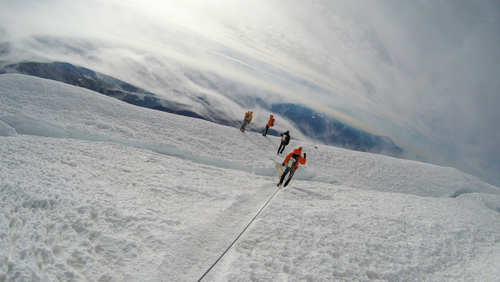 As one of the most picturesque mountains in North America, Mount Rainier is a popular destination for hikers and backpackers. Unfortunately, it’s also one of the most dangerous. The first part of the trail is deceivingly easy as it meanders through meadows of wildflowers. It isn’t until you reach the 2.2-mile, 2,800-vertical-foot climb up Muir Snowfield that things start to get thrilling. Over the course of the 14,410 feet it takes to get to the summit, hikers are likely to face major fatigue. Falling rocks can also be a danger.
As one of the most picturesque mountains in North America, Mount Rainier is a popular destination for hikers and backpackers. Unfortunately, it’s also one of the most dangerous. The first part of the trail is deceivingly easy as it meanders through meadows of wildflowers. It isn’t until you reach the 2.2-mile, 2,800-vertical-foot climb up Muir Snowfield that things start to get thrilling. Over the course of the 14,410 feet it takes to get to the summit, hikers are likely to face major fatigue. Falling rocks can also be a danger.
But the biggest danger to hikers on Mount Rainier is something perhaps unexpected: the weather. Storms frequently roll in from the Pacific Ocean, and shroud the entire mountain in a dense fog. This rapid phenomenon often brings with it snow, falling rocks, wind speeds up to 70mph, and even avalanches. More than 400 hikers have perished attempting to climb Mount Rainier, at least 90 of whom have fallen to their deaths after slipping on frozen terrain.
Mount Washington
New Hampshire
New Hampshire’s Mount Washington is a very pretty, mildly strenuous hike. So what’s a place with that description doing on our list of the continent’s most thrilling hikes? Mount Washington has been named the world’s most dangerous small mountain. Indeed, it even proudly declares itself “Home to the World’s Worst Weather.” A hike that begins in a warm valley can turn into a windy, below-freezing hell by the time a hiker reaches the summit. The wind velocity record is 231 mph on Mount Washington, though even a 60 mph “breeze” here can feel strong enough to force hikers off course. This extreme weather means avalanches and hypothermia are the biggest dangers to hikers. So far, 130 climbers have perished while climbing Mount Washington.
Paso de Cortes
Estado de México, México
Located not too far from one of our other thrilling hikes, Iztaccihuatl, is Paso de Cortes. Named for the Spanish conquistador Hernan Cortes, the Paso runs right between two volcanoes. Though the hike is located only about two hours outside of Mexico City, the whole experience feels a world away. It’s essential that anyone who attempts Paso de Cortes be physically fit and an experienced hiker, as altitude sickness frequently proves to be climbers’ biggest foe. Getting to the summit can be a challenge, but those who accomplish it are rewarded with one heck of a stunning view.
Peek-a-Boo Gulch
Grand Staircase-Escalante, Utah
Peek-a-Boo Gulch may not be the longest, deepest, or even narrowest trail in the Grand Staircase-Escalante trail area, but it is one of the most thrilling. Enter this 3.5-mile loop hike through Dry Fork, where you’ll have to climb down stairs carved into the canyon wall. The stairs are pretty steep, and dotted with potholes that are oftentimes filled with water. Though getting down into the slot canyon is about the most physically demanding that it gets, Peek-a-Boo Gulch does require some rock-scrambling skills and a lot of common sense. There are myriad twists and chutes, and as with most other slot canyon trails in the American Southwest, heat can be an issue.
Rover’s Run Trail
Far North Bicentennial Park, Anchorage, Alaska
Located in Far North Bicentennial Park, Alaska’s Rover’s Run Trail is actually quite leisurely. There are no steep drops, no extreme weather risks, no loose rocks, and no dangerous vertical climbs. But there are lots of bears. Rover’s Run is most popular during the summer, which also happens to be when brown bears travel here in droves in order to fish salmon out of the nearby rivers. While park officials have tried diverting the trail away from the rivers, and have even gone as far as temporarily “closing” the trail to the public, bear encounters and maulings are frequent. Even moose, though perhaps not quite as scary as bears, are commonly sighted along the trail, and have been known to violently charge “intruders.”
South Kaibab Trail
The Grand Canyon, Arizona
The South Kaibab Trail doesn’t make the typical list of dangerous hikes. As the quickest trail down to the floor of the Grand Canyon, it’s a deservedly popular route. Still, it’s a trail worthy of respect. Temperatures here routinely hover above 110 degrees Fahrenheit, and there are very few spots for shade along the path. Thus, dehydration, sickness, and heat stroke are extremely common while hiking the South Kaibab Trail. The trail is also difficult to maintain, so torn-up spots, logs, and small boulders are common things to have to traverse. Recent years have seen a number of reported deaths here, including one woman who fell over the ledge after letting a faster hiker pass her.
The Wave
Coyote Buttes, Arizona
The Wave is one of the Southwest’s most scenic features. In fact, this rolling red rock is so popular that a lottery system has been put in place to experience it. But this in-demand geographical feature doubles as one of North America’s most thrilling hikes. Only 20 hikers are allowed to take it on each day — probably so that rangers can ensure all who go in come out. Surprisingly dangerous, The Wave hike has killed a number of people, including one month in which it killed three. There is no marked trail here, and the confusing landscape looks the same in all directions. Summer temperatures often top 110 degrees Fahrenheit, and there aren’t any shady spots along the trail. For these reasons, the Bureau of Land Management has said about The Wave, “This is not just a nice little stroll in the park on a hot day. It’s a dangerous situation, and you better be prepared.”
The West Coast Trail
Vancouver, British Columbia
The West Coast Trail was constructed in 1907 to guide shipwreck survivors from the coastline of Vancouver Island. With fewer shipwrecks occurring these days, the trail has become one of Canada’s best-known hikes. It’s also one of Canada’s most thrilling hikes. Rugged and dangerous, the West Coast Trail extends for 75 kilometers (46.6 miles) over varied terrain. The biggest challenges for hikers include illness, injury, and hypothermia. Of the approximately 6,000 people who set off on the West Coast Trail each year, an average of 60 need to be rescued at some point along the way.

